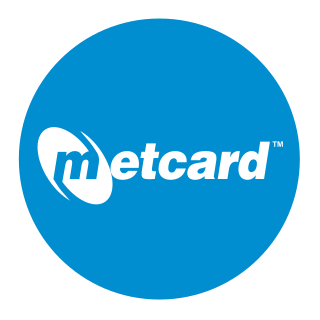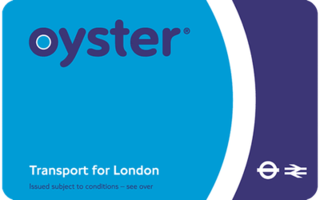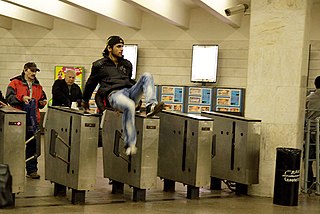
Metcard was the brand name of an integrated ticketing system used to access public transport in Melbourne, Australia. It was a universal ticket which allowed users to ride on the city's Metlink and Metropolitan Transit Authority network, consisting of suburban trains, trams, and buses, including the NightRider network. The Metcard was a credit card-sized ticket made out of cardboard and used a magnetic strip to store fare data. Metcard was operated by OneLink Transit Systems under a contract with the Government of Victoria which was managed by the Transport Ticketing Authority.

The Oyster card is a payment method for public transport in London in England, United Kingdom. A standard Oyster card is a blue credit-card-sized stored-value contactless smart card. It is promoted by Transport for London (TfL) and can be used on travel modes across London including London Buses, London Underground, the Docklands Light Railway (DLR), London Overground, Tramlink, some river boat services, and most National Rail services within the London fare zones. Since its introduction in June 2003, more than 86 million cards have been used.

A ticket machine, also known as a ticket vending machine (TVM), is a vending machine that produces paper or electronic tickets, or recharges a stored-value card or smart card or the user's mobile wallet, typically on a smartphone. For instance, ticket machines dispense train tickets at railway stations, transit tickets at metro stations and tram tickets at some tram stops and in some trams. Token machines may dispense the ticket in the form of a token which has the same function as a paper or electronic ticket. The typical transaction consists of a user using the display interface to select the type and quantity of tickets and then choosing a payment method of either cash, credit/debit card or smartcard. The ticket(s) are then printed on paper and dispensed to the user, or loaded onto the user's smartcard or smartphone.

The Travelcard is an inter-modal travel ticket for unlimited use on the London Underground, London Overground, Elizabeth line, Docklands Light Railway, London Trams, London Buses and National Rail services in the Greater London area. Travelcards can be purchased for a period of time varying from one day to a year, from Transport for London, National Rail and their agents. Depending on where it is purchased, and the length of validity, a Travelcard is either printed on a paper ticket with a magnetic stripe or encoded onto an Oyster card, Transport for London's contactless electronic smart card, or an ITSO smartcard issued by a National Rail train operating company. The cost of a Travelcard is determined by the area it covers and, for this purpose, London is divided into a number of fare zones. The Travelcard season ticket for unlimited travel on London Buses and the London Underground was launched on 22 May 1983 by London Transport. One Day Travelcards and validity on other transport modes were added from 1984 onwards. The introduction of the Travelcard caused an increase in patronage and reduced the number of tickets that needed to be purchased by passengers.

London Buses is the subsidiary of Transport for London (TfL) that manages most bus services in London, England. It was formed following the Greater London Authority Act 1999 that transferred control of London Regional Transport (LRT) bus services to TfL, controlled by the Mayor of London.

An electronic ticket is a method of ticket entry, processing, and marketing for companies in the airline, railways and other transport and entertainment industries.
SmartRider is the contactless electronic ticketing system of the Public Transport Authority of Western Australia. The system uses RFID smartcard technology to process public transport fares across public bus, train and ferry services.
Revenue protection inspector (RPI) or revenue protection officer (RPO) is the job title given to staff who patrol different forms of public transport issuing penalty fares to passengers who travel without a valid ticket or without the correct ticket.
The London Underground metro system of London, England uses a mix of paper and electronic smart-card ticketing.
Translink is the public transit agency for Queensland, and is part of the Department of Transport and Main Roads. Translink was first introduced by the Queensland Government in June 2003 to orchestrate bus, ferry, rail and light rail services. They work with Brisbane Airtrain, Transport for Brisbane, RiverCity Ferries, Queensland Rail and other operators to provide services. Translink operates an integrated ticketing system across Queensland and the go card system to allow the use of one ticket on multiple services in South East Queensland.

Myki, stylised as myki, is a reloadable credit card-sized contactless smart card ticketing system used for electronic payment of fares on most public transport services in Melbourne and regional Victoria, Australia. Myki replaced the Metcard ticketing system and became fully operational at the end of 2012.
Public transport ticketing in New South Wales, Australia operated using magnetic-stripe technology between 1989 and 2016. This ticketing system, known variously as the Automated fare collection system, STATS and, from 2010, MyZone, was progressively replaced by a contactless smart card called Opal between 2012 and 2016.

Avantix Mobile ("AVB") is a portable railway ticket issuing system used across the British railway network from 2001 to 2017.

Fare evasion or fare dodging is the act of travelling on public transport without paying by deliberately not buying a required ticket to travel. It is considered a problem in many parts of the world, and revenue protection officers and ticket barriers, staffed or automatic, are in place to ensure only those with valid tickets may access the transport. The term fare avoidance is sometimes used as a euphemistic synonym and sometimes used to refer to the lawful use of much cheaper tickets.

Manual fare collection is the practice of collecting fares manually. "Fare collection" generally refers to the collection of fares in the transport industry in return for a ticket or passes to travel. Commonly used on buses and train transport systems, manual fare collection is increasingly becoming obsolete with the introduction of smart cards such as the Transport for London 'Oyster card'. However, in the face of this trend, some companies have opted to retain more traditional methods of manual fare collection to both save money and ensure reliability. In the United Kingdom, examples of this can be seen on the Transport for London Heritage lines and the FirstGroup FTR routes in York, Leeds, Luton, and Swansea where bus conductors have returned to work. The other reason(with lowering prices of electronics, and in most cases need to buy it once) may be for Heritage routes - tradition "look", for other routes(because of quite high monthly labor cost in UK) agreements and strong unions with the tries from politics to lower the unemployment rate by making overworking in public service.
A penalty fare, standard fare, or fixed penalty notice is a special, usually higher, fare charged because a passenger using public transport did not comply with the normal ticket purchasing rules. It should not be confused with an unpaid fares notice.

The OV-chipkaart is a contactless smart card system used for all public transport in the Netherlands. First introduced in the Rotterdam Metro in April 2005, it has subsequently been rolled out to other areas and travel modes. It fully replaced the national strippenkaart system for buses, trams, and metro trains in 2011, and the paper ticket system for rail travel in July 2014.
The Bus Reshaping Plan of 1966 was a plan devised by the London Transport Board for the reorganisation of bus routes in London, England. The main features of the plan, which was to be rolled out over ten to fifteen years, were:

MetroCARD is a contactless smartcard ticketing system for public transport services in the Adelaide city and suburbs in South Australia. The system is managed by Adelaide Metro and is usable on their bus, train and tram services.

The Gibson A14 ticket machine is a handheld, hand-powered apparatus for issuing bus tickets from a blank paper roll, formerly used by London Transport (LT) and operated by a conductor or guard. It was in use from 1953 until 1993, was designed by former London Transport Superintendent of fare collection at LT's Effra Road ticket machine works, George Gibson. It was manufactured by Ticket Issuing Machines Limited.















